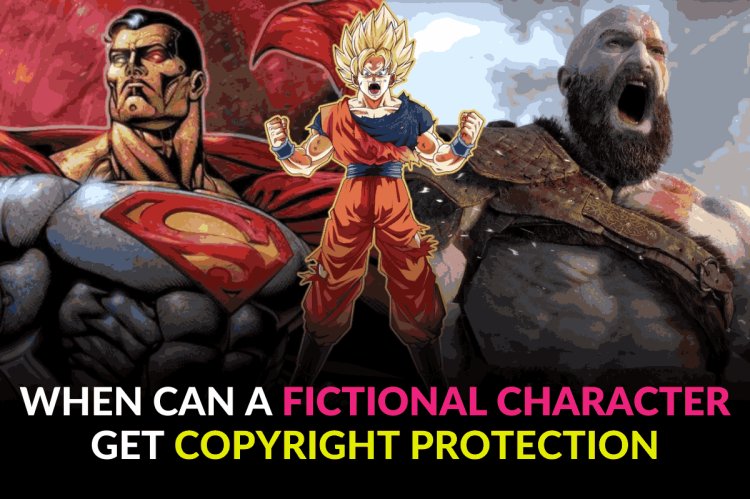WHEN CAN A FICTIONAL CHRACTER GET COPYRIGHT PROTECTION
The Article throws light on the aspect of granting copyright protection to Fictional characters. Since the law relating to this matter is evolving, the Article would be discussing judicial precedents and various standards laid down in such cases for granting copyright protection to such characters. From the judicial trends, it can be clearly seen that the courts have granted full protection to such characters in case the character is fully developed and has special characteristics.

INTRODUCTION
Copyright is crucial even in fictional realms, where characters and their stories are protected as intellectual property. Authors and creators rely on copyright to safeguard the uniqueness and integrity of their fictional characters, preventing unauthorized use or adaptation. This legal framework ensures that creators retain control over their creations, fostering creativity and enabling the commercialization of fictional works in various forms of media.
Certain standards have evolved through case law jurisprudence to determine whether fictional character is developed or not.
1. Test of Delineation:
It lays focus on the development of the character. The character should have evolved in a manner that it can be separated from the main story.
In Nicholas v. Universal Pictures Corporation (1930), it was held that “To determine whether a character is delineated a three-step test has been applied which are (a) the presence of physical and personality attributes specific to the character; (b) the presence of attributes identifiable in different contexts; (c) the presence of unique elements of expression which must be present through the narrative.” It can be better understood with examples of Marvel movies characters. Marvel produces its movies like Avengers involving various characters like Thor, Captain America, Iron Man etc. But each of these characters are capable of being alienated and separated and therefore a separate series or movies it’s launched for each character like Iron Man movies etc.
In Anderson v Stallone (1989), appellant wrote a story inspired from the character ‘Rocky’ from ‘Rocky’ movie series. Court said that since the character of rocky was identifiable based on the physical and emotional attributes, it is protectable by copyright law. Therefore, the appellant was prevented from incorporating the character of ‘Rocky’ in his book.
2. Story Being Told Standard:
It essentially lays down that the character which is seeking copyright protection must be the main focal point of story and not just incidental. That is around that character the whole story must revolve., character of Jethalal from popular India sitcom ’Tarak Mehta KA ULTA CHASMA “has evolved and the whole story revolves around that character and therefore Copyright Protection maybe provided to such characters.
In Warner Bros. Inc. v. CBS Inc. (1985), it was concerned with providing copyright protection to the character ‘REGAN’ from Exorcist. Court said that this character was not central to the theme and therefore refused to grant copyright protection.
3. Comparative Analysis
Similarly, in Detective Comics v Bruns Publication (1940), the character of Superman had a typical dress which consists of blue with red cape and underwear on top. Now Burn Publication developed a character, Wonder Woman with has close resemblance with Superman. The Court did comparative analysis of two characters in order to determine whether these characters have similarities or not. Although, there were differences in dress but the super power abilities of both characters were almost same. The character of Wonder woman had similar characteristics and traits as that of Superman.
Similarly, in case of Raja Pocket Books v Radha Pocket Books (1997), plaintiff main character of comics ’NAGRAJ’ was a superhero who wear a green suit, had a typical hairstyle and was inspired from snake God. The defendant Radha comic books developed a similar character called ‘NAGESH” with similar looks and almost possessing same powers. The court found after analysis that Radha Comics was doing copyright infringement by copying the character ‘NAGRAJ’ by causing deception among consumers.
ISSUES WITH RESPECT TO COPYRIGHTABILITY OF FICTIONAL CHARCTERS
1. Idea v Expression
One of the Landmark case titled Detective Comics v Burns Publications, DC comics popular character of Superman who has wide range of abilities. The court said Superman is inspired from Greek Mythology and therefore make it an idea under public domain which cannot be copyrightable. As one of the important principle of copyright is an idea is not copyrightable but the expression is. So anyone can create a superhero character inspired from mythologies as the mere idea is not copyrightable. But the representation of that particular character in a proper form if done by that comics is copyrightable. In this case the particular events, story line of the character etc. was copied by Burn Comics and therefore it constituted copying of the depiction of Superman. Therefore, court passed order against Burns Publication.
2. Characters in Public Domain
There are certain characters which represents an element of commonality. These characters are general in nature and do not have any special traits and hence they are not copyrightable. For copyright protection there is element of fully development of that character ranging from its style, specific traits, action, conduct. In Arbaaz Khan Production Private Limited v Northstar Entertainment Private Limited and Ors (2016), the specific portrayal of character of police officer named ‘Chul Bul Pandey’ has special features like typical moustache, style of talking, dance style and story main character places a scenario wherein it showcases that such characters can seek copyright protection. But there are certain Characters like Alladin, Sherlock Homes, Frankenstien Monster etc which are considered as part of Public Domain i.e It means these characters cannot seek copyright protection and sereval TV series, movies are based on such characters.
3. Unauthorized Merchandising
Character merchandising refers to the adaptation or secondary exploitation of the essential personality features (such as the name, image, or appearance) of a character by the creator of a fictional character or by one or several authorized third parties in relation to various goods and/or services with a view to creating in prospective customers a desire to acquire those goods and/or to use those services because of the customers’ affinity with that character. For example, Walt Disney, started providing licenses to companies for usage of their characters like MicKey Mouse, Donald Duck on bags, watches etc. Similarly, we have seen Chota bheem , Doaremon etc cartoon characters being used on different products.
In Diamond Comic Pvt. Ltd. and Anr. vs. Raja Pocket Books and Ors (2005), the defendant terminated the contract of assignment with plaintiff and started publishing his own comics using character ‘Shaktiman’ of plaintiff. The court held that such publication by defendant is unauthorized as it was making commercial gain from unauthorized merchandising of ‘shaktiman’ character.
CONCLUSION
1. Limitation of Copyright Law: The original works of the author in literary, dramatic, artistic, etc. is protected by the under section 13 of Copyright Act,1957. It simply means the whole story or drama is protected but not the individual characters of that story or drama. There are chances when there is alteration made to these characters and certain new traits are added, then the copyright law in India is still nascent to cover this aspect. For example, Harry Potter character is altered by adding some new characteristics and expressed in new book, then he might not get protection under original copyright book.
2. Problem arising due to non- Codification: Since there is no particular statute providing copyright protection to character, then sole reliance is based on judicial precedents. But after analysis of various tests, it can be seen that when can a character be said to be fully developed. These criteria can deem to vary. For example, character of ‘Sheldon Cooper’ from TV series ‘Big bang Theory’, had special features and traits and a dress style and so a series was also made on him. But can the same principle be applied to character of ‘Kabir Singh’ because of his style and way of conduct. It is for the courts and statute to determine that where the line needs to be drawn for a character to seek copyright protection.












